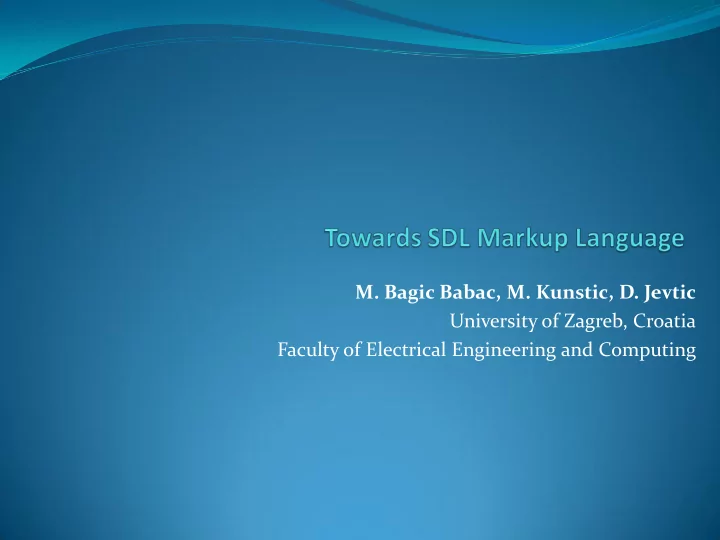

M. Bagic Babac, M. Kunstic, D. Jevtic University of Zagreb, Croatia Faculty of Electrical Engineering and Computing
Content Introduction SDL Markup Language SDL-ML Example Conclusion SAM 2010: Towards SDL Markup Language 2
Introduction: XML applications An XML based version of SDL for data interchange. XML is widely used for data storage and data transmission: web based, extensible, license-free, platform independent, easy display formatted XML data in browser, can be used with database queries that return XML, etc. XML Rob Jill Anthony Sally Pete SAM 2010: Towards SDL Markup Language 3
XML transformations Media for data interchange B2B transactions on the Web Workflow applications - applications where documents are moved around a community of people who each perform on it Transformation and presentation: [Source: Extensible Stylesheet Language Version 1.0, http://www.w3c.org/TR/xsl/] SAM 2010: Towards SDL Markup Language 4
SDL Markup Language An XML based interchange format for SDL Z.106 ITU-T, Common Interchange Format (CIF) for SDL, 2002 . (SDL-PR) Figure 1. SDL-PR, SDL-GR, SDL-ML SAM 2010: Towards SDL Markup Language 5
SDL-PR, SDL-GR, SDL-ML SDL-ML (vs. CIF): independent of tools and platforms, supported with XML technologies, a data storage tools do not need a dedicated SDL-PR parser, a new self contained language, easily extended, also based on SDL-PR syntax conforms to the abstract grammar of SDL, no “end...” closing keywords, but has closing tags. SDL-PR, SDL-GR, SDL-ML are equivalent. SAM 2010: Towards SDL Markup Language 6
SDL to SDL-ML Process interaction diagrams can be included in blocks. The root block is called system. Figure 2. SDL and XML Hierarchy SAM 2010: Towards SDL Markup Language 7
SDL-ML Grammar and Lexic SDL covers the basic aspects of OO: identity classification polymorphism inheritance SDL allows for the specification of: system/ block/ process type service/ procedure type signal /data type Figure 3. SDL-ML Tree SAM 2010: Towards SDL Markup Language 8
System (type) Contains: <sdl:system> system declarations part <sdl:use> 1. <sdl:package> type declarations part 2. <sdl:name> packetABC </sdl:name> block interaction part 3. </sdl:package> </sdl:use> <sdl:name> SystemABC </sdl:name> System type can be parameterised or a <sdl:system_type> <sdl:name> typeABC </sdl:name> specialisation of another <sdl:fpar> system type. <sdl:parameter> <sdl:name> par1 </sdl:name> </sdl:parameter> Block specifications or </sdl:fpar> <sdl:inherits> .... </sdl:inherits> instantiations of block types <sdl:process_type> ... </sdl:process_type> <sdl:service_type> ... </sdl:service_type> <sdl:procedure> ... </sdl:procedure> </sdl:system_type> </sdl:system> SAM 2010: Towards SDL Markup Language 9
Block (type) <sdl:block> <sdl:name> blockABC </sdl:name> Block type is a local <sdl:no_of_instances> 3 </sdl:no_of_instances> specification within a system <sdl:block_type> (or a system type) <sdl:name> typeABC </sdl:name> <sdl:fpar> specification, or a remote <sdl:parameter> specification within a <sdl:name> par1 </sdl:name> </sdl:parameter> package (a block type </sdl:fpar> reference). <sdl:inherits> ... </sdl:inherits> <sdl:process_type> ... </sdl:process_type> <sdl:service_type> ... </sdl:service_type> Block type can be <sdl:procedure> ... </sdl:procedure> parameterised or a specialisation of another </sdl:block_type> </sdl:block> block type. <sdl:gate> <sdl:name> gateC </sdl:gate> <sdl:out> <sdl:to> <sdl:with> sig </sdl:with> </sdl:to> </sdl:out> <sdl:in> <sdl:from> SAM 2010: Towards SDL Markup Language 10 <sdl:with>
Process (type) A process type reference may appear in a package, a system <sdl:process> <sdl:name> processABC </sdl:name> specification, a system type <sdl:no_of_instances> specification, a block <sdl:init> 3 </sdl:init> <sdl:max> 10 </sdl:max> specification, or a block type </sdl:no_of_instances> specification. <sdl:process_type> Can be parameterised or a specialisation of another <sdl:name> typeABC </sdl:name> <sdl:fpar> process type. <sdl:parameter> <sdl:name> par1 </sdl:name> <sdl:gate> </sdl:parameter> <sdl:name>gateB</sdl:name> </sdl:fpar> <sdl:out> <sdl:inherits> .... </sdl:inherits> <sdl:to> <sdl:with>sig</sdl:with> <sdl:service_type> ... </sdl:service_type> </sdl:to> <sdl:procedure> ... </sdl:procedure> </sdl:out> ..... <sdl:in> <sdl:from> <sdl:state> ... </sdl:state> <sdl:with>sig<sdl:with> </sdl:from> </sdl:process_type> </sdl:in> </sdl:gate> </sdl:process> SAM 2010: Towards SDL Markup Language 11
Service (type) <sdl:service> A service type reference may <sdl:name> serviceABC </sdl:name> appear in the specifications of <sdl:service_type> a package, system, system <sdl:name> servicetypeABC </sdl:name> <sdl:fpar> type, block, block type, <sdl:parameter> process and process type. <sdl:name> par1 </sdl:name> </sdl:parameter> </sdl:fpar> <sdl:inherits> .... </sdl:inherits> A service type specification may be instantiated in a ... <sdl:procedure> ... </sdl:procedure> process specification or a <sdl:state> ... </sdl:state> process type specification. </sdl:service_type> </sdl:service> SAM 2010: Towards SDL Markup Language 12
Procedure <sdl:procedure> <sdl:name> serviceABC </sdl:name> <sdl:fpar> <sdl:parameter> <sdl:name> par1 </sdl:name> <sdl:sort> in </sdl:sort> Procedure is a specification of </sdl:parameter> a type by itself. </sdl:fpar> <sdl:dcl> <sdl:variable> <sdl:name> var1 </sdl:name> Procedure is instantiated when <sdl:sort> Integer </sdl:sort> a procedure call in a process, </sdl:variable> </sdl:dcl> service or procedure is interpreted <sdl:inherits> <sdl:procedure> <sdl:name> proc </sdl:name> </sdl:procedure> <sdl:adding> ... </sdl:adding> </sdl:inherits> ... <sdl:state> ... </sdl:state> </sdl:procedure> SAM 2010: Towards SDL Markup Language 13
Signal (type) <sdl:signal> Signal type is a specification of <sdl:name> signalA </sdl:name> a type by itself. <sdl:sort> Integer </sdl:sort> <sdl:refinement> Signal type is instantiated <sdl:subsignal> subA </sdl:subsignal> </sdl:refinement> when an output statement in a process, service or procedure is <sdl:inherits> interpreted. <sdl:signal> <sdl:name> signalBasic </sdl:name> </sdl:signal> <sdl:adding> Signal type can be <sdl:parameter> parameterized, or be a <sdl:name> newPar </sdl:name> <sdl:sort> newSort </sdl:sort> specialisation. </sdl:parameter> </sdl:adding> </sdl:inherits> </sdl:signal> SAM 2010: Towards SDL Markup Language 14
SDL-ML examples < sdl:system id=“31”> < sdl:name >HelloWorld</ sdl:name > < sdl:block id=“51”> < sdl:name >HelloWorld</ sdl:name > < sdl:process id=“63”> < sdl:name >HelloWorld</ sdl:name > < sdl:channel id=“6”> < sdl:name >Ch_Game_Env</ sdl:name > < sdl:type >delaying</ sdl:type > < sdl:direction >one</ sdl:direction > < sdl:from_to > < sdl:from >env</ sdl:from > < sdl:to >Gate_b</ sdl:to > < sdl:with > < sdl:signal > < sdl:name >Yes</ sdl:name > </ sdl:signal > </ sdl:with > </ sdl:from_to > </ sdl:channel > SAM 2010: Towards SDL Markup Language 15
Extended FSM < sdl:state id=“42”> < sdl:name >Winning</ sdl:name > < sdl:input > < sdl:name >Probe</ sdl:name > < sdl:parameter >Val</ sdl:parameter > </ sdl:input > < sdl:output > < sdl:name >Result</ sdl:name > </ sdl:output > < sdl:nextstate >idle </ sdl:nextstate > </ sdl:state > < sdl:start id=“1”> < sdl:task id=“23”> < sdl:statement >Val:=Val+1;</ sdl:statement > < sdl:join >labelA</ sdl:join > </ sdl:task > SAM 2010: Towards SDL Markup Language 16
Recommend
More recommend